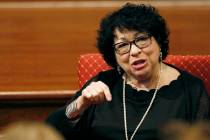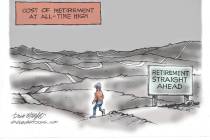After all these ‘cuts,’ still spending the same
Cries of poverty at the Clark County School District have been loud and frequent over the past several years, but claims of "cuts" at the district have been wildly exaggerated.
For months, officials have been telling the public that the district in recent years made more than $500 million in cuts to its general fund spending, with the amount rising to "nearly $600 million" in the past few weeks.
These statements have also been widely repeated by the media:
■ Bloomberg News: [Declining property values have] required the Clark County School District - the nation's fifth-largest - to cut $500 million from its budget in four years, said Jeff Weiler, the district's chief financial officer.
■ Las Vegas Sun: Furthermore, the district has cut more than $500 million since 2007, [CCSD spokeswoman Amanda] Fulkerson said.
■ 8 News Now: CCSD Lobbyist Joyce Haldeman stated, "We've had $600 million in budget cuts over the last four years."
■ Las Vegas Review-Journal: "... Not if the district's budget continues to dwindle, [Superintendent Dwight] Jones warned. Nearly $600 million has been cut in the past four years."
■ "Nevada Week in Review": Trustee Dr. Rene Cantu stated, "The school district budget has been cut $600 million over the last four years."
There's just one problem. As even a casual glance at the school district's own general-fund spending statistics reveals, what the district has been saying is not true.
When contacted by the Nevada Policy Research Institute, CCSD provided a spreadsheet showing the "cuts" that supposedly total $596 million. An inspection of the spreadsheet, however, reveals that many of the listed "cuts" are merely decreases in spending increases the district wanted.
Supposedly the "cuts" began in the 2008-09 school year, when, even though CCSD's general fund spending increased by $58 million, officials reported cutting $133 million. For the next year, when CCSD spending increased by $12 million, officials report another $120 million in "cuts."
In 2010-11 and 2011-12, CCSD's spending did decrease - by
$70 million. CCSD has been telling the public, however, that it cut its budget a whopping $283 million. During the current year, when CCSD is projecting its spending to increase by $16 million, an additional $60 million in "cuts" supposedly occurred.
In actuality, CCSD's projected level of spending for the current school year, $2.107 billion, is only $54 million, or 2.6 percent, below its all-time peak spending level of 2009-10. Meanwhile, its enrollment has been essentially flat over the past six years, fluctuating between 308,000 and 311,000 students.
If CCSD had received funding for all the "cuts" it claims to have made, general-fund spending would have grown from $2.091 billion ($2.247 billion after adjusting for inflation) in 2007-08 to $2.703 billion for the current school year - an inflation-adjusted, per-pupil spending increase of 20 percent in only four years. That's what education bureaucrats were demanding during Nevada's worst economic downturn in at least half a century.
CCSD's casual dishonesty with the public about these mythical spending "cuts" speaks loudly about the district's real priorities. Yes, it's another tedious example of government bureaucrats assuming a spending increase and then crying about "cuts" when spending doesn't increase as much as they would like. But it's more.
By focusing on these imaginary cuts, CCSD officials shifted the conversation away from the real reasons why the district chronically fails a huge proportion of its students. The district also led the public away from what's actually been driving spending increases - such as the problems with collective bargaining and binding arbitration - and into a phony discussion of spending levels.
For Nevadans serious about genuine public education reform and who want to be hopeful about the current CCSD administration, it is a dispiriting sight: an institution established to foster learning instead using its lobbying and communications shops to spread a cynical falsehood.
Deceiving the public about spending cuts may lead to a bigger haul of taxpayer dollars, but it's also a betrayal of education's core values.
Victor Joecks is communications director at the Nevada Policy Research Institute. For more visit http://npri.org.























